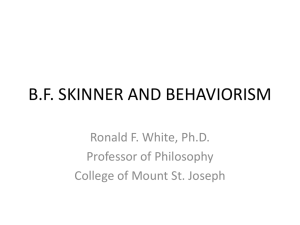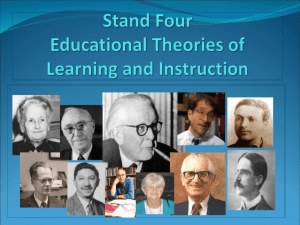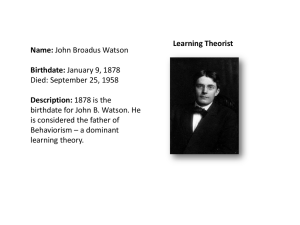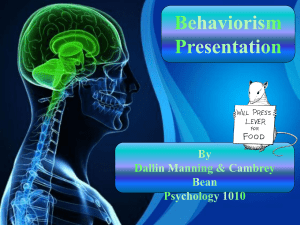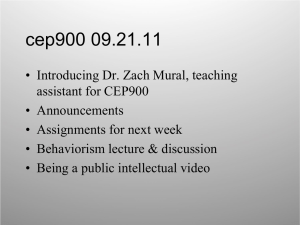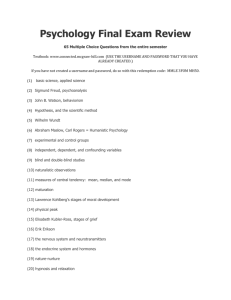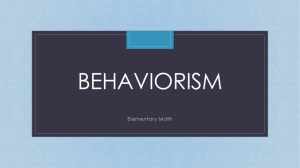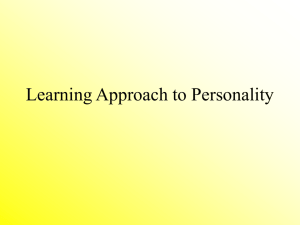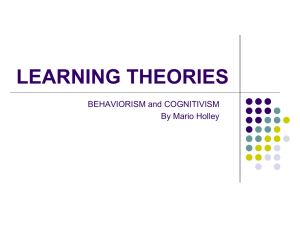Behaviorism notes tuesday
advertisement
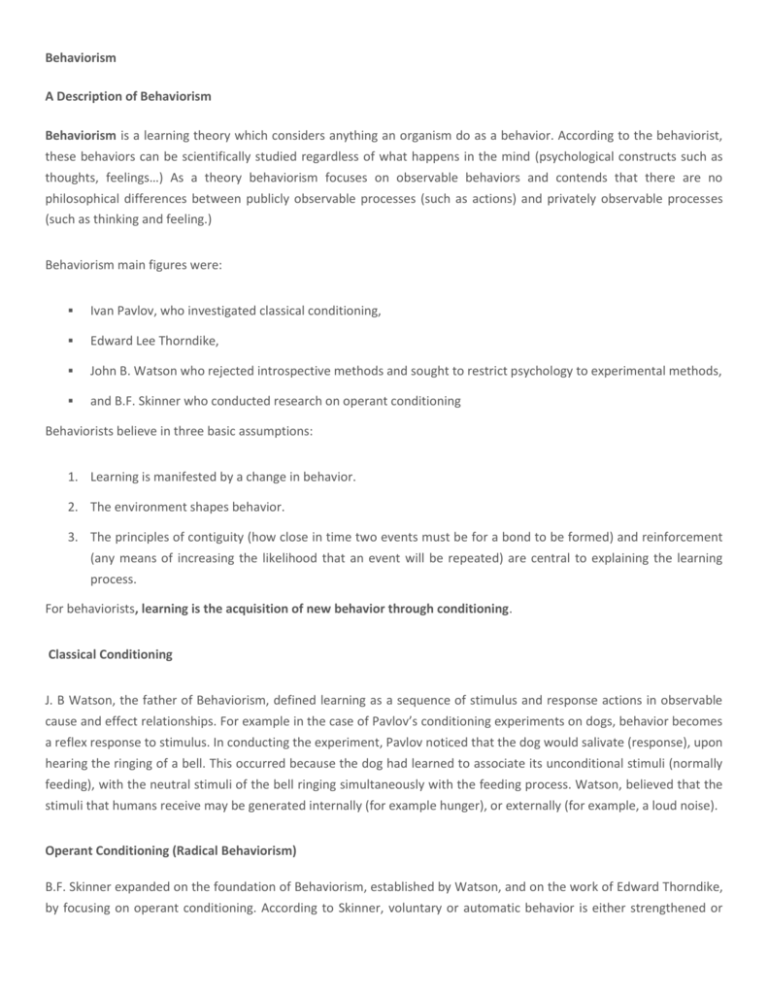
Behaviorism A Description of Behaviorism Behaviorism is a learning theory which considers anything an organism do as a behavior. According to the behaviorist, these behaviors can be scientifically studied regardless of what happens in the mind (psychological constructs such as thoughts, feelings…) As a theory behaviorism focuses on observable behaviors and contends that there are no philosophical differences between publicly observable processes (such as actions) and privately observable processes (such as thinking and feeling.) Behaviorism main figures were: Ivan Pavlov, who investigated classical conditioning, Edward Lee Thorndike, John B. Watson who rejected introspective methods and sought to restrict psychology to experimental methods, and B.F. Skinner who conducted research on operant conditioning Behaviorists believe in three basic assumptions: 1. Learning is manifested by a change in behavior. 2. The environment shapes behavior. 3. The principles of contiguity (how close in time two events must be for a bond to be formed) and reinforcement (any means of increasing the likelihood that an event will be repeated) are central to explaining the learning process. For behaviorists, learning is the acquisition of new behavior through conditioning. Classical Conditioning J. B Watson, the father of Behaviorism, defined learning as a sequence of stimulus and response actions in observable cause and effect relationships. For example in the case of Pavlov’s conditioning experiments on dogs, behavior becomes a reflex response to stimulus. In conducting the experiment, Pavlov noticed that the dog would salivate (response), upon hearing the ringing of a bell. This occurred because the dog had learned to associate its unconditional stimuli (normally feeding), with the neutral stimuli of the bell ringing simultaneously with the feeding process. Watson, believed that the stimuli that humans receive may be generated internally (for example hunger), or externally (for example, a loud noise). Operant Conditioning (Radical Behaviorism) B.F. Skinner expanded on the foundation of Behaviorism, established by Watson, and on the work of Edward Thorndike, by focusing on operant conditioning. According to Skinner, voluntary or automatic behavior is either strengthened or weakened by the immediate presence of reinforcement or punishment. New learning occurs as a result of positive reinforcement and undesirable behavior is discarded through negative reinforcement. Teaching and Behaviorism When applying the tenets (principles) of Behaviorism to education, Skinner contends that teaching is the arrangement of contingencies of reinforcement under which students learn. Of course students learn without being taught in their natural environments, but when teachers arrange special contingencies, this accelerates learning. That is these contingencies will speed up the emergence of behavior which would otherwise be acquired slowly or make sure the desired behavior would appear, which otherwise would never occur. (Skinner, 1968, p.64) Examples of the applications in teaching Here some of the applications of behaviorism in education: Directed instruction (a teacher provides the knowledge to the students either directly or through the set up of “contingencies”) The use of exams to measure observable behavior of learning. The use of rewards and punishments in our school systems. The audiolingual approach to language teaching. and the breaking down of the instruction process into “conditions of learning” (as developed by Robert Gagne) Criticism of Behaviorism Behavioral theories do not account for free will and internal influences such as moods, thoughts, and feelings. As a learning theory, Behaviorism doesn’t take into account important internal processes that take place in the mind. Language acquisition was one type of learning Skinners learning theory cannot account for. Chomsky for example, responding to Skinner’s Verbal behavior, shows that language acquisition occurs because of some innate abilities that children are endowed with which explains that they can produce an indefinite number of utterances they have never heard. There are many instances of learning that occurs without the use of reinforcements or punishments. People and animals are able to adapt their behavior when new information is introduced, even if a previous behavior pattern has been established through reinforcement. Behaviorists focus on the target, desirable behavior, that is the product. They fail to explain how humans learn, the process through which the learning takes place. For a behaviorist what occurs between the stimulus and the response (the black box) is of little importance. The very meaning of the learning process is banned from any scientific analysis in the behavioristic approach (the black box shouldn’t be opened.) Conclusion As a learning theory Behaviorism focuses on the observable behavior which they claim must be the subject of a scientific study. Although this type of study will yield measurable results, and can be applicable to a number of cases, such as in treatments for human disorders including autism, anxiety disorders and antisocial behavior, it fails to account for the learning process and how the mind and the affective domain interfere in the processing of information. New learning approaches and theories appeared in the 20th century as a response to these shortcomings. Cognitivism and constructivism are the major trends of this movement. References N. Chomsky, (1957) “A Review of BF Skinner’s Verbal Behavior.” Skinner, B.F., Beyond Freedom & Dignity, Hackett Publishing Co, Inc 2002. Skinner, B.F. (1938). The behavior of organisms. New York: Appleton-Century-Crofts. Skinner, B.F. (1945). The operational analysis of psychological terms. Psychological Review. 52, 270–277, 290–294. Skinner, B.F. (1953). Science and Human Behavior. Skinner, B.F. (1957). Verbal behavior. Englewood Cliffs, NJ: Prentice-Hall. Skinner, B.F. (1969). Contingencies of reinforcement: a theoretical analysis. New York: Appleton-Century-Crofts. Skinner, B.F. (31 July, 1981). “Selection by Consequences”. Science 213 (4507): 501–504. Staddon, J. (2001) The new behaviorism: Mind, mechanism and society. Philadelphia, PA: Psychology Press. pp. xiii, 1–211. Watson, J.B. (1913). Psychology as the behaviorist views it. Psychological Review, 20, 158–177. Watson, J.B. (1919). Psychology from the Standpoint of a Behaviorist. Watson, J.B. (1924). Behaviorism.
